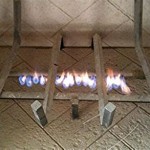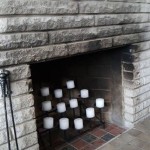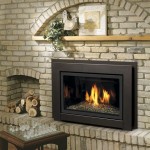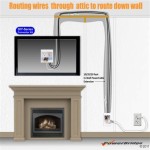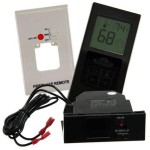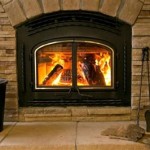Outdoor Patio Fireplaces: Enhancing Outdoor Living Spaces
Outdoor patio fireplaces have become increasingly popular additions to residential landscapes, offering a focal point for relaxation, entertainment, and extending the usability of outdoor spaces beyond the warmer months. These structures provide warmth, ambiance, and a visual aesthetic that can significantly enhance the appeal and value of a property. When considering an outdoor patio fireplace, numerous factors must be evaluated, including fuel type, design, building codes, and maintenance requirements. Understanding these aspects is crucial for making informed decisions and ensuring a safe and enjoyable outdoor fire experience.
The primary purpose of an outdoor patio fireplace is to provide warmth and extend the outdoor season. During cooler evenings, a fireplace can create a comfortable and inviting environment for gatherings with family and friends. Beyond the practical benefit of warmth, a fireplace serves as a visual anchor within a patio or deck area. The flickering flames and radiant heat contribute to a relaxed and convivial atmosphere, making it an ideal spot for socializing or quiet contemplation. The aesthetic appeal of a well-designed fireplace can also significantly increase a property’s curb appeal and overall value.
Fuel Options for Outdoor Patio Fireplaces
The choice of fuel is a foundational consideration when selecting an outdoor patio fireplace. The most common options include wood-burning, gas-fueled (natural gas or propane), and electric models. Each fuel type offers distinct advantages and disadvantages concerning cost, convenience, environmental impact, and maintenance requirements.
Wood-burning fireplaces offer the quintessential outdoor fire experience, providing the crackling sounds, authentic smell, and visual allure associated with a traditional fire. However, they also require a significant commitment to fuel sourcing and storage. Wood must be seasoned properly to burn efficiently and produce minimal smoke. Furthermore, wood-burning fireplaces necessitate regular cleaning to remove ash and creosote buildup, and they are subject to local regulations regarding open burning and air quality.
Gas-fueled fireplaces offer a more convenient and cleaner-burning alternative to wood. Natural gas fireplaces are typically connected to a home's existing gas line, providing a consistent and readily available fuel source. Propane fireplaces utilize portable propane tanks or a larger, permanently installed tank. Gas fireplaces are easy to ignite and control, offering adjustable flame heights and heat output. They also produce less smoke and ash than wood-burning models, simplifying maintenance. However, gas fireplaces lack the authentic ambiance of wood fires, and the cost of installation, including gas line connections, can be substantial.
Electric fireplaces represent the simplest and most convenient option, requiring only a standard electrical outlet. They produce no smoke, ash, or emissions, making them an environmentally friendly choice. Electric fireplaces typically feature realistic flame simulations and adjustable heat settings. While they offer ease of use and minimal maintenance, they generally produce less heat than wood or gas fireplaces and do not replicate the authentic fire experience. Their primary advantage lies in their portability and ability to be used indoors and outdoors, depending on the model.
Design and Materials for Outdoor Patio Fireplaces
The design and materials used in constructing an outdoor patio fireplace significantly impact its aesthetic appeal, durability, and integration with the surrounding landscape. A wide range of styles and materials are available, allowing homeowners to customize their fireplace to complement their existing patio design and personal preferences.
Design styles range from traditional brick or stone fireplaces to contemporary models constructed from metal or concrete. Traditional designs often incorporate natural stone, brick, or stucco to create a rustic and timeless look. Contemporary designs may feature clean lines, geometric shapes, and modern materials such as stainless steel or concrete. The chosen design should harmonize with the architectural style of the house and the overall aesthetic of the outdoor space.
Material selection is crucial for ensuring the longevity and weather resistance of the fireplace. Natural stone, such as granite, limestone, or slate, offers exceptional durability and a natural aesthetic. Brick is another popular choice, providing a classic and durable finish. Concrete is a versatile material that can be molded into various shapes and textures, offering a modern and customizable look. Metal, particularly stainless steel, is often used in contemporary designs for its sleek appearance and corrosion resistance. Regardless of the material chosen, it should be appropriate for outdoor use and able to withstand exposure to the elements, including rain, snow, and extreme temperatures.
Consideration should also be given to incorporating built-in features such as seating, storage for wood or propane tanks, or decorative elements such as mantels or hearths. These additions can enhance the functionality and visual appeal of the fireplace, making it a more integrated and inviting element of the patio.
The size of the fireplace should be proportional to the size of the patio. A large fireplace can overwhelm a small patio, while a small fireplace may be insufficient to provide adequate warmth in a larger space. Careful planning and measurement are essential to ensure that the fireplace is appropriately scaled to the area.
Safety Regulations and Building Codes for Outdoor Patio Fireplaces
The construction and use of outdoor patio fireplaces are subject to local building codes and safety regulations. These regulations are designed to ensure the safe and responsible use of fire and to prevent potential hazards such as fire spread, carbon monoxide poisoning, and property damage. It is essential to familiarize oneself with these regulations before installing or using an outdoor fireplace.
Building permits are typically required for the construction of permanent outdoor fireplaces. These permits ensure that the fireplace meets all applicable safety standards and is constructed according to code. The permit application process may involve submitting detailed plans and specifications, as well as undergoing inspections during and after construction.
Setback requirements specify the minimum distance that a fireplace must be located from structures, property lines, and combustible materials. These setbacks are designed to prevent the spread of fire and protect surrounding properties. Local regulations may also specify restrictions on the height and size of the fireplace.
Fire safety measures are paramount to ensure the safe operation of an outdoor fireplace. A spark arrestor is typically required for wood-burning fireplaces to prevent embers from escaping and potentially igniting nearby materials. A fire extinguisher or water source should be readily available in case of emergency. It is crucial to regularly inspect and maintain the fireplace to ensure that it is in good working condition and free from hazards.
Ventilation requirements are particularly important for gas-fueled fireplaces. Proper ventilation is necessary to prevent the buildup of carbon monoxide, a colorless and odorless gas that can be deadly. Gas fireplaces should be installed and maintained by a qualified professional to ensure that they are properly vented and operating safely.
Adhering to all applicable building codes and safety regulations is not only a legal requirement but also a crucial step in ensuring the safety and enjoyment of an outdoor patio fireplace. Consulting with local authorities and qualified professionals can help homeowners navigate the regulatory landscape and ensure that their fireplace is installed and operated in a safe and responsible manner.
Beyond design and core building specifications, considerations for placement must be taken into account. Wind direction is important to avoid directing smoke towards seated guests or adjacent buildings. Similarly, proximity to trees with overhanging branches should be carefully assessed to prevent potential fire hazards. Adequate clearance from combustible materials is paramount.
Regular maintenance is also essential for safe and efficient operation. For wood-burning fireplaces, this includes removing ash, cleaning the chimney to prevent creosote buildup, and inspecting the firebox for cracks or damage. Gas fireplaces should be inspected annually by a qualified technician to ensure proper functioning of the gas lines, burners, and safety devices. All types of fireplaces should be kept free of debris and obstructions.
The functionality of the outdoor patio fireplace can be further enhanced with different accessories. Fireplace screens not only add a decorative element but also provide safety by containing sparks and embers. Grates are useful for elevating firewood, thereby promoting better airflow and a more efficient burn. Log holders offer a convenient and organized way to store firewood near the fireplace. Pokers and shovels are essential tools for tending the fire and removing ash.
Landscaping around the fireplace can also contribute to the overall ambiance and functionality of the outdoor space. Planting fire-resistant plants is a prudent safety measure. Seating arrangements, such as benches or Adirondack chairs, invite guests to gather around the fire and enjoy the warmth and ambiance. Lighting, such as string lights or lanterns, can create a more intimate and inviting atmosphere. Rugs can define the space and add a touch of comfort.

How To Build An Outdoor Fireplace Step By Guide Buildwithroman

30 Outdoor Fireplace Ideas Cozy Fireplaces

53 Most Amazing Outdoor Fireplace Designs Ever

Outdoor Fire Pits And Fireplaces Katy Houston Greater Areas

Outdoor Fireplace Ideas The Home Depot

Outdoor Fireplace Kits Stonewood S Cape Cod Ma Nh Ct
:max_bytes(150000):strip_icc()/bring-holidays-outside-x-50f80e4865984b36b603a1de82d2938b.jpg?strip=all)
Glowing Outdoor Fireplace Ideas

Five Fabulous Outdoor Fireplace Ideas Coogans Landscape Design

Everything Outdoors Outdoor Fireplaces

Outdoor Fireplaces Diy Kits Plans Cape Cod Ma Ri
Related Posts

